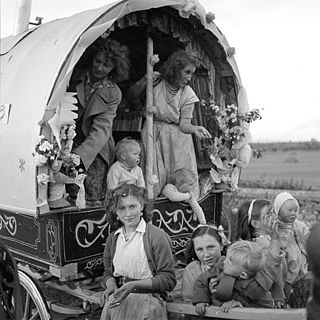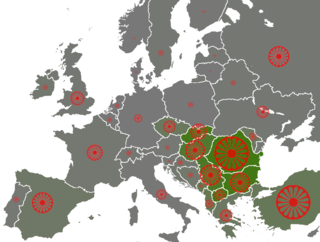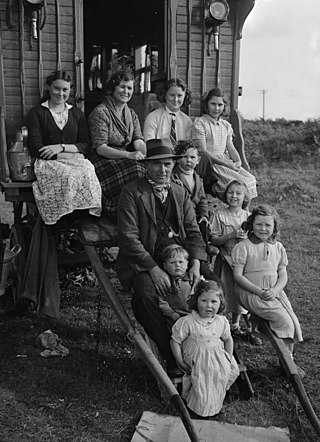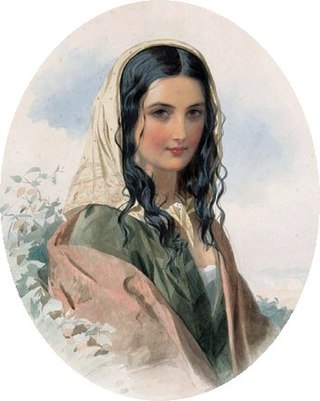
Irish Travellers, also known as Pavees or Mincéirs, are a traditionally peripatetic indigenous ethno-cultural group originating in Ireland.
Shelta is a language spoken by Mincéirí, particularly in Ireland and the United Kingdom. It is widely known as the Cant, to its native speakers in Ireland as de Gammon or Tarri, and to the linguistic community as Shelta. Other terms for it include the Seldru, and Shelta Thari, among others. The exact number of native speakers is hard to determine due to sociolinguistic issues but Ethnologue puts the number of speakers at 30,000 in the UK, 6,000 in Ireland, and 50,000 in the US. The figure for at least the UK is dated to 1990. It is not clear if the other figures are from the same source.
Pikey is an ethnic slur referring to Gypsy, Roma and Traveller people. It is used mainly in the United Kingdom and in Ireland to refer to people who belong to groups which had a traditional travelling lifestyle. Groups referred to with this term include Irish Travellers, English Gypsies, Welsh Kale, Scottish Lowland Travellers, Scottish Highland Travellers, and Funfair Travellers. These groups consider the term to be highly offensive.
A cant is the jargon or language of a group, often employed to exclude or mislead people outside the group. It may also be called a cryptolect, argot, pseudo-language, anti-language or secret language. Each term differs slightly in meaning; their uses are inconsistent. Richard Rorty defines cant by saying that "'Cant', in the sense in which Samuel Johnson exclaims, 'Clear your mind of cant,' means, in other words, something like that which 'people usually say without thinking, the standard thing to say, what one normally says'." In Heideggerian terms it is what "das Man" says.
Angloromani or Anglo-Romani is a mixed language of Indo-European origin involving the presence of Romani vocabulary and syntax in the English used by descendants of Romanichal Travellers in the United Kingdom, Australia, Canada, New Zealand, United States, and South Africa.

The Romanichal are a Romani subgroup within the United Kingdom and other parts of the English-speaking world. Most Romanichal speak Angloromani, a mixed language that blends Romani vocabulary with English syntax. Romanichal resident in England, Scotland, and Wales are part of the Gypsy, Roma, and Traveller community.
The term English Travellers refers to itinerant groups, and may mean:

A Vardo is a four-wheeled horse-drawn vehicle used by British Romanichal Travellers as their home. It is pulled by a single horse in shafts, sometimes with a second horse hitched on its right side outside the shafts to help pull heavier loads or assist in pulling up a hill. The vehicle is typically highly decorated, intricately carved, brightly painted, and even gilded. The Romanichal Traveller tradition of the vardo is seen as a high cultural point of both artistic design and a masterpiece of woodcrafter's art.
Welsh Romani is a variety of the Romani language which was spoken fluently in Wales until at least 1950. It was spoken by the Kale group of the Romani people who arrived in Britain during the 16th century. The first record of Romani moving permanently into Wales comes from the 18th century. Welsh-Romani is one of the many Northern Romani dialects.

The languages of Scotland belong predominantly to the Germanic and Celtic language families. The main language now spoken in Scotland is English, while Scots and Scottish Gaelic are minority languages. The dialect of English spoken in Scotland is referred to as Scottish English.
The Norwegian and Swedish Romanisæl Travellers are a group or branch of the Romani people who have been resident in Norway and Sweden for some 500 years. The estimated number of Romanisael Travellers in Sweden is 65,000, while in Norway, the number is probably about 10,000.

The Romani people have several distinct populations, the largest being the Roma and the Calé, who reached Anatolia and the Balkans in the early 12th century, from a migration out of the Indian subcontinent beginning about 1st century – 2nd century AD. They settled in the areas of present-day Turkey, Greece, Serbia, Romania, Croatia, Moldova, Bulgaria, North Macedonia, Hungary, Albania, Kosovo, Bosnia and Herzegovina, Czech Republic, Slovenia and Slovakia, by order of volume, and Spain. From the Balkans, they migrated throughout Europe and, in the nineteenth and later centuries, to the Americas. The Roma population in the United States is estimated at more than one million.

The Kale are a group of Romani people in Wales. Many claim to be descendants of Abram Wood, who was the first Rom to reside permanently and exclusively in Wales in the early 18th century, although Romanichal Travellers have appeared in Wales since the 16th century. Welsh Kale are almost exclusively found in Northwest Wales, specifically the Welsh-speaking areas. Romanichal Travellers inhabit South Wales and North East Wales.
The Romani people are known by a variety of names, mostly under the broad categories of gipsy, tsinganoi, Bohémiens, and Roma. Self-designation varies: In Central and Eastern Europe, Roma is common. The Romani of England call themselves Gypsies, Romanies, Romany Gypsies or Romanichal, those of Scandinavia Romanisæl. In German-speaking Europe, the self-designation is Sinti, in France Manush, while the groups of Spain, Wales, and Finland use Kalo/Kale. There are numerous subgroups and clans with their own self-designations, such as the Kalderash, Machvaya, Boyash, Lovari, Modyar, Xoraxai, and Lăutari.
The Showmen's Guild of Great Britain exists to protect the interests of Travelling Showmen in Great Britain.
Scottish Cant is a cant spoken in Scotland by Lowland Scottish Romani Travellers.

There are a number of traditionally itinerant or travelling groups in Europe who are known as Travellers or Gypsies.

Romani people have been recorded in the United Kingdom since at least the early 16th century. There are estimated to be around 225,000 Romani residing in the UK. This includes the Romanichal, Welsh Kale and a sizeable population of Eastern European Roma, who immigrated into the UK in the late 1990s/early 2000s and after EU expansion in 2004. They are considered part of the Gypsy, Roma and Traveller (GRT) community. Romani people in the UK are predominantly Christian, with 71.8% of English and Welsh Romani identifying as Christian in the 2021 census compared to 46.2% of the wider population.
Gypsy, Roma and Traveller is an umbrella term used in the United Kingdom to represent several diverse ethnic groups which have a shared history of nomadism. The groups include Gypsies, defined as communities of travelling people who share a Romani heritage, resident in Britain since the 16th century; Ethnic Travellers, the traditional travelling people of Ireland and Scotland; and Roma, who are defined as recent Romani migrants from Eastern Europe. Although these groups' traditional lifestyles involved travel, most GRT people now live in houses or permanent caravan berths.







